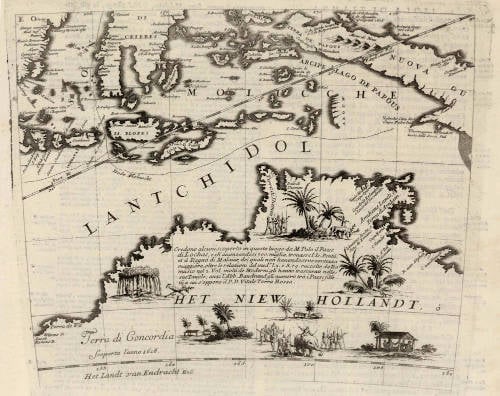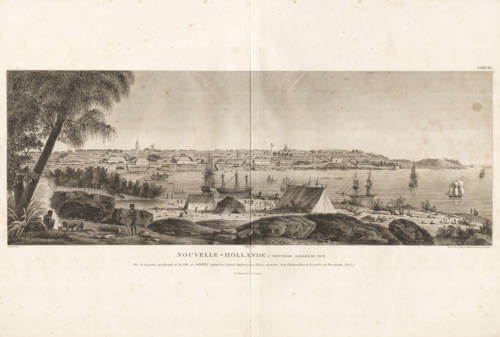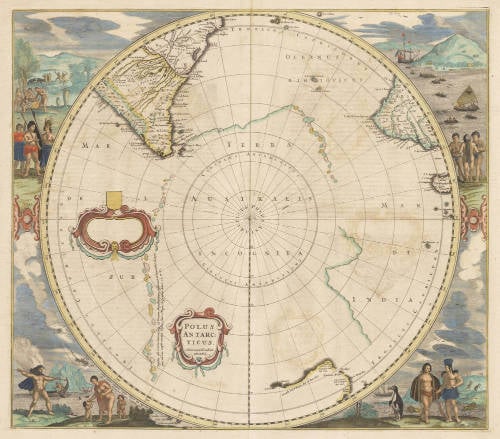Leen Helmink Antique Maps
Set of six antique prints of King George Sound by Sainson
Stock number: 19353
Zoom ImageCartographer(s)
Louis Auguste de Sainson (biography)
Title
au port du Roi Georges
First Published
Paris, 1833
This Edition
1833 first edition
Size
35.0 x 50.0 cms
Technique
Condition
excellent
Price
$ 4,500.00
(Convert price to other currencies)
Description
Set of 6 original Lithographs: Plates 10, 13, 14, 15, 16, 23, taken from the Voyage de la Corvette L'Astrolabe execute pandant les annees 1826-29 le commandement de Jules Dumont D'Urville, Capital de vaisseau.
The scenes were recorded in King George Sound (present day Albany and Oyster Harbour in southwestern Australia) during the first voyage of the corvette Astrolabe under the command of Jules Dumont d'Urville.
Coquille was renamed Astrolabe in honour of one of the ships of La Pérouse. She sailed from Toulon on 22 April 1826, towards the Pacific Ocean, for a circumnavigation of the world that was destined to last nearly three years. The voyage had a particular focus on the aborigines and ethnography they encountered.
In October 1826 the expedition explored the area of King George Sound, present day Albany and Oyster Harbour in Southwestern Australia, before skirting the coast of southern Australia. The six lithographs here were all made around King George Sound.
The litographs were made after drawings from life by Louis de Sainson, the expedition artist.
Published in Paris in 1833 in the official accounts of the voyage.
Condition
1833 first edition. Here in stunning original hand colour. Wide margins, with the blind stamp of the expedition in the lower margin. Excellent overall.
Early European visits to King George Sound
The first reported visit to King George Sound by a European was in 1791 by the English explorer Captain George Vancouver. Vancouver named it King George the Third's Sound after the reigning monarch.
The next Europeans to visit the sound were Captain Dennis of the Kingston, and Captain Dixson of the Elligood. Kingston and Elligood were whalers and while there caught three whales. Dixson left an inscribed piece of copper plate behind.
Matthew Flinders anchored in the sound from 8 December 1801 to 5 January 1802 and explored the area. While he was there, his men found the copper plate Dixson had left. During this time Robert Brown (ship's botanist) and Peter Good (ship's gardener) collected samples of over 500 plant species.
Nicolas Baudin arrived in the sound in February 1803 aboard Le Geographe to rendezvous with Louis de Freycinet aboard the Casuarina before doing further exploration of the Western Australian coastline. During the course of their stay the ship's naturalist François Péron, collected 1060 new species of shellfish and a large number of starfish from the sound.
Phillip Parker King visited the sound in 1818 aboard the cutter HMS Mermaid[13] while en route to conduct a nautical survey of the North West Cape,[14] and Frenchman Dumont d'Urville visited it in 1826 aboard the Astrolabe.
On 25 December 1826, the New South Wales colonial government brig Amity, under the command of Major Edmund Lockyer, arrived at King George Sound to establish a possessory military settlement. Lockyer named his settlement Fredrick Town after George III's second son, Prince Frederick, Duke of York and Albany, but this name never gained wide acceptance. Instead the settlement and surrounding locality were usually referred to as King George's Sound.
The settlement of King George's Sound was part of New South Wales – a semi-exclave of New South Wales – from its establishment until 7 March 1831. It then was made part of the Swan River Colony, which from 1833 has been known as Western Australia.
In 1832, Governor of Western Australia Captain (later Admiral) James Stirling declared the settlement a town and renamed it Albany, but the broader locality continued to be referred to as King George's Sound for many years.
In 1834 Robert Dale published in London a panorama print of the view from Mount Clarence accompanied by a pamphlet describing the sound and the geography, geology, flora, fauna and native inhabitants of the immediate region.
On 8 March 1836, HMS Beagle visited King George Sound and anchored there for eight days. On board was the young naturalist Charles Darwin, who collected specimens on shore. Beagle was on the homeward leg of her celebrated circumnavigation of the world, having already stopped off at Sydney.
Until the construction of Fremantle Harbour in 1897, King George Sound contained the only deepwater port in Western Australia, and so was the favoured location for delivery of mail and supplies from abroad to Western Australia. These were then transported to Perth and Fremantle by road or coastal shipping until the early 1890s, when the completion of the Great Southern Railway provided a quicker service.
(Wikipedia)
Louis Auguste de Sainson
A watercolourist and draughtsman, Louis Auguste de Sainson was born in Paris on 26 April 1800. He began his lengthy naval career in a secretarial position in France which enabled him to travel to Australia and create hundreds of drawings and engravings.
Sainson was born in Paris on 26 April 1800, according to his personal service file. He began his naval career in a secretarial position at the French Atlantic port of Rochefort, working there from 21 August 1825 until 6 January 1826, then volunteered to join the Astrolabe as a draughtsman. He was recommended to the expedition’s commander Jules Dumont d’Urville by Quoy, one of the naturalists, and joined the ship at Toulon on 7 February 1826. Until the ship returned to France on 1 April 1829 de Sainson earned his monthly salary of 100 francs by producing a total of nearly 500 drawings.
The Astrolabe first visited Australia from early October to late December 1826 (King George Sound, Westernport, and Jervis Bay, Sydney). It made a second visit from mid-December 1827 to early January 1828 (Hobart Town). A large collection of de Sainson’s drawings is on deposit in the French National Archives. A small collection of watercolours (Bibliothéque Nationale, Paris) includes two Australian subjects: View taken in George’s Street at Sydney and an untitled work corresponding to the published lithograph of the view of the clearings at the foot of Mount Wellington, Van Diemen’s Land. There is no independent evidence that he ever painted in oils and for this and other reasons the traditional attribution to de Sainson of an unsigned, undated oil painting, Inauguration du Monument Élevé par L’Astrolabe á La Pérouse é Vanikoro, 14 Mars, 1828 (NLA), was questioned in 1984. The identification, description and analysis of the vast number of lithographs, etchings and engravings after de Sainson are extensive and still almost virgin areas of investigation.
From 11 June 1829 to 31 December 1834 de Sainson was a member of the editorial team preparing the official account of the expedition for publication. One engraving of five Aboriginal portraits after de Sainson appeared in the Zoological Atlas : one engraving and 36 lithographs of Australian artefacts, landscapes, townscapes and further Aboriginal subjects were included in the Historical Atlas . Careful though de Sainson’s portraits are, as Bernard Smith has said, they 'veer occasionally towards the ignoble and comic savage when he depicts Australian aborigines, as they err on the side of the romantic when he depicts the Maori. But his drawings do mark a considerable advance upon the work of his predecessors.’
In November 1829, at Dumont d’Urville’s request, de Sainson was promoted commis de marine 3e classe . He became a Chevalier de la Légion d’Honneur in August 1831 and a commis de 2e classe in September 1833, having applied for promotion a month earlier. Some time before this he began editorial work on the Album Historique illustrating the voyage of La Favorite and in June 1835 applied for three months’ leave from his regular service to bring this to a conclusion. Several of the aquatints in this volume are after drawings by de Sainson, none of an Australian subject. On 21 May 1836, he was appointed to a position in the central administration but resigned on 1 June. The following year (1837) found him as secretary to a French scientific mission travelling in southern Russia and in that context his portrait was lithographed by Raffet in 1848. No reliable biographical details have yet been discovered beyond this, although guesses about his year of death have been made.
(Design and Art Australia Online)
Related Categories
Related Items






